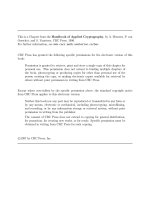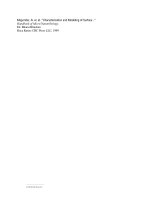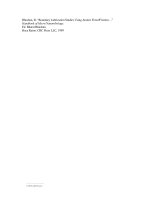Handbook of poultry diseases
Bạn đang xem bản rút gọn của tài liệu. Xem và tải ngay bản đầy đủ của tài liệu tại đây (11.12 MB, 210 trang )
ASA HANDBOOK ON
POULTRY DISEASES
Simon M. Shane
FRCVS, PhD, MBL, ACPV
Adjunct Professor
North Carolina State University
Professor Emeritus
School of Veterinary Medicine
Louisiana State University
USA
Published by:
American Soybean Association
541 Orchard Road
#11-03 Liat Towers
Singapore 238881
Tel: (65) 6737 6233
Fax: (65) 6737 5849
Website: www.asasea.com
www.pdfgrip.com
Handbook on Poultry Diseases
2nd Edition
Copyright©2005 by American Soybean Association
All Rights Reserved. No part of this publication may be produced or distributed in any form or
by any means, or stored in a data base or retrieval system, without prior written permission of
the copyright owners.
Printed in Singapore, 2005
PO 52-2005
MITA (P) 052/04/2005
MO4GX19403-062005-1000
www.pdfgrip.com
HANDBOOK ON POULTRY DISEASES
www.pdfgrip.com
ASA WORLD HEADQUARTERS
American Soybean Association
12125 Woodcrest Executive Drive
Suite 100 St. Louis
MO 63141-5829, USA
Tel: (1314) 576-1770
Fax: (1314) 576-2786
ASA INTERNATIONAL OFFICES
THAILAND
Mr. Opas Supamornpun, Consultant
American Soybean Association
59/43 Baan Klang Muang
Ladprao 71 Road
Ladprao, Bangkok 10230
THAILAND
Phone: (662) 5395373, 5395332
Fax: (662) 539 5256
Email:
SOUTHEAST ASIA
Mr. John A Lindblom,
Regional Director
American Soybean Association
541 Orchard Road
#11-03 Liat Towers
REPUBLIC OF SINGAPORE 238881
Phone: (65) 6737-6233
Fax: (65) 6737-5849
Email:
Website: www.asasea.com
VIETNAM
Mr. Tran Trong Chien, Consultant
American Soybean Association
13/F Hanoi Towers
49 Hai Ba Trung Street
Hanoi, Vietnam
Phone: (844) 934 3979
Fax: (844) 934 3966
Email:
INDONESIA
Mr. Ali Basry, Consultant
American Soybean Association
Wisma Mitra Sunter, #402
Blok C-2 Boulevar Mitra Sunter
Jl Yos Sudarso Kav. 89, Jakarta 14350
INDONESIA
Phone: (6221) 651 4752
Fax: (6221) 651 4753
Email:
PHILIPPINES
Mr. Teodoro M Cortes, Consultant
American Soybean Association
1408-B, Robinsons - Equitable Tower
#4 ADB Avenue cor. Poveda, Ortigas Ctr.
1605 Pasig City, MM
PHILIPPINES
Phone: (632) 637 5387
Fax: (632) 637 5388
Email:
PEOPLE’S REPUBLIC OF CHINA
Mr. Phillip Laney,
Country Director
American Soybean Association
Suite 902 China World Tower 2
No. 1 Jianguomenwai Avenue
BEIJING 100004, PRC
Phone: (8610) 6505-1830
Fax: (8610) 6505-2201
Email:
American Soybean Association
Rm. 1802, SITC
No. 2201 Yanan Xi Lu
SHANGHAI, 200336, PRC
Phone: (8621) 6219-1661
Fax: (8621) 6219-5590
Email:
www.pdfgrip.com
KOREA
Mr. Say Young Jo,
Country Director
American Soybean Association
Rm 301, 3rd Floor, Leema Building
146-1 Susong-dong, Chongro-ku
Seoul 110-755
KOREA
Phone: (822) 738-7056
Fax: (822) 736-5501
Email:
Website: www.asa.or.kr
ASIA SUBCONTINENT
Mr. Virgil Miedema, Director
American Soybean Association
149 Jor Bagh
New Delhi - 110 003
INDIA
Phone: (91 11) 2465-1659
Fax: (91 11) 2465-1526
Email:
Website: www.asaasc.com
JAPAN
Mr. Takehiko Nishio,
Country Director
American Soybean Association
7th Fl., Toshin Tameike Building
1-1-14 Akasaka
Minato-ku, Tokyo 107-0052
JAPAN
Phone: (81 3) 5563-1414
Fax: (81 3) 5563-1415
Email:
Website: www.asajapan.org
TAIWAN
Mr. Anthony Thang,
Country Director
American Soybean Association
6 Fl., No. 27, Chang An East Road, Section
1, Taipei 104,
TAIWAN
Phone: (8862) 2560-2927
Fax: (8862) 2568-3869
Email:
Website: www.soybean.org.tw
WEST EUROPE & OTHER AFRICAN COUNTRIES
Regional Director
American Soybean Association
Rue du Luxembourg, 16b,
1000 Brussels, BELGIUM
Phone: (32 2) 548 9380
Fax: (32 2) 502-6866
Email:
Website: www.asa-europe.org
MEXICO
Mr. Mark Andersen,
Regional Director
Asociacion Americana de Soya
U.S. Agriculture Trade Office
Jaime Balmes #8, 2do. Piso
Col. Los Morales Polanco
MEXICO, D.F. C.P. 11510
Phone: (52 55) 5281-0120 ext. 230
Fax: (52 55) 5281-6154 & 281-0147
Email:
Website: www.soyamex.com.mx
TURKEY & MIDDLE EAST
Mr. Christopher Andrew,
Regional Director
American Soybean Association
BJK Plaza, Suleyman Seba Cad. No. 92
A-Blok, Kat-8 No. 85/86
80680 Besiktas, Istanbul, TURKEY
Phone: (90 212) 258 2800
Fax: (90 212) 236 2620
Email:
www.pdfgrip.com
TABLE OF CONTENTS
PREFACE 1
MANAGEMENT, NUTRITION AND BIOSECURITY ......................... 2
1.0
INTRODUCTION ............................................................................... 3
2.0
ECONOMIC CONSIDERATIONS IN THE PREVENTION AND
CONTROL OF POULTRY DISEASES .............................................. 6
2.1
2.2
2.3
3.0
HEALTH AND PERFORMANCE OF POULTRY IN TROPICAL
CLIMATES .......................................................................................... 13
3.1
3.2
3.3
4.0
General Principles ................................................................... 6
Fixed and Variable Costs in Poultry Production ..................... 7
Gross Marginal Analysis ......................................................... 8
Physiological Effects of High Ambient Temperature ............. 13
Design of Housing in Tropical Countries ............................... 13
Management of Flocks at High Temperature .......................... 15
PREVENTION OF DISEASE ............................................................ 21
4.1
Mechanisms of Disease Transmission .................................... 21
4.1.1 Transovarial Route ..................................................... 21
4.1.2 Transmission on the Egg Shell ................................... 21
4.1.3 Direct Transmission ................................................... 21
4.1.4 Indirect Transmission ................................................. 22
4.1.5 Dissemination by Wind .............................................. 22
4.1.6 Biological Vectors ...................................................... 22
4.1.7 Feed ............................................................................ 22
4.1.8 Vaccines ..................................................................... 22
4.2
Biosecurity .............................................................................. 23
4.2.1 Conceptual Biosecurity .............................................. 23
4.2.2 Structural Biosecurity ................................................ 23
4.2.3 Operational Biosecurity ............................................. 24
4.3
Decontamination of Housing and Equipment ......................... 26
4.3.1 Definitions .................................................................. 26
4.3.2 Decontamination ........................................................ 26
i
www.pdfgrip.com
4.3.3
4.3.4
4.4
4.5
4.6
4.7
5.0
5.3
5.4
7.0
Disinfection of Poultry Houses ............................................... 27
Control of Rodents .................................................................. 28
Control of Free-Living Birds .................................................. 29
Quality of Water ...................................................................... 30
VACCINATION AND MEDICATION ............................................... 35
5.1
5.2
6.0
Disinfectants ............................................................... 26
Public Health Considerations ..................................... 27
General Principles ................................................................... 35
Significance of Maternal Antibody
in Relation to Flock Protection ............................................... 35
Administration of Vaccines ..................................................... 38
Medication .............................................................................. 38
SPECIAL PROCEDURES RELATING TO CONTROL OF
DISEASES IN POULTRY OPERATIONS ......................................... 46
6.1
Control of Disease in Multiplier Breeder Farms .................... 46
6.1.1 Structural Biosecurity ................................................ 46
6.1.2 Operational Biosecurity ............................................. 47
6.2
Control of Disease on Commercial Broiler Farms ................. 47
6.2.1 Structural Biosecurity ................................................ 47
6.2.2 Operational Biosecurity ............................................. 48
6.3
Control of Disease in Commercial Egg Production Units ...... 51
6.3.1 Operational Biosecurity ............................................. 51
6.4
Control of Disease in Hatcheries ............................................ 53
6.4.1 Structural Biosecurity ................................................ 53
6.4.2 Operational Biosecurity ............................................. 53
NUTRITION OF CHICKENS AND DIETARY DEFICIENCIES ..... 56
7.1
7.2
Establishing Nutritional Specifications .................................. 56
Nutrient Deficiencies .............................................................. 56
7.2.1 Causes of Nutrient Deficiencies ................................. 56
7.2.2 Low Energy Intake ..................................................... 57
7.2.3 Deficiencies of Proteins or Amino Acids ................... 57
7.2.4 Fats ............................................................................. 57
7.2.5 Oxidative Rancidity ................................................... 58
ii
www.pdfgrip.com
7.2.6 Vitamin Deficiencies ..................................................... 58
7.3
Quality Control in Feed Manufacture ..................................... 62
IMMUNOSUPPRESSIVE DISEASES ..................................................... 68
8.0
MAREK’S DISEASE .......................................................................... 69
8.1
8.2
8.3
8.4
8.5
8.6
8.7
9.0
Etiology ................................................................................... 69
Occurrence and Economic Significance ................................. 69
Transmission ........................................................................... 69
Clinical Signs .......................................................................... 69
Pathology ................................................................................ 69
Diagnosis and Confirmation ................................................... 69
Prevention ............................................................................... 70
INFECTIOUS BURSAL DISEASE .................................................... 72
9.1
9.2
9.3
9.4
9.5
9.6
9.7
Etiology ................................................................................... 72
Occurrence and Economic Significance ................................. 72
Transmission ........................................................................... 72
Clinical Signs .......................................................................... 72
Pathology ................................................................................ 73
Diagnosis ................................................................................ 73
Prevention ............................................................................... 73
10.0 CHICKEN ANEMIA ........................................................................... 76
10.1
10.2
10.3
10.4
10.5
10.6
10.7
Etiology ................................................................................... 76
Occurrence and Economic Significance ................................. 76
Transmission ........................................................................... 76
Clinical Signs .......................................................................... 76
Pathology ................................................................................ 76
Diagnosis ................................................................................ 76
Prevention ............................................................................... 76
RESPIRATORY DISEASES ..................................................................... 78
11.0 NEWCASTLE DISEASE ................................................................... 79
11.1
11.2
11.3
Etiology ................................................................................... 79
Occurrence and Economic Significance ................................. 79
Transmission ........................................................................... 79
iii
www.pdfgrip.com
11.4
11.5
11.6
11.7
Clinical signs........................................................................... 80
Pathology ................................................................................ 80
Diagnosis ................................................................................ 80
Prevention ............................................................................... 81
12.0 INFECTIOUS LARYNGOTRACHEITIS .......................................... 84
12.1
12.2
12.3
12.4
12.5
12.6
12.7
Etiology ................................................................................... 84
Occurrence and Economic Significance ................................. 84
Transmission ........................................................................... 84
Clinical Signs .......................................................................... 84
Pathology ................................................................................ 84
Diagnosis ................................................................................ 84
Prevention ............................................................................... 85
13.0 AVIAN INFLUENZA ......................................................................... 87
13.1
13.2
13.3
13.4
13.5
13.6
13.7
13.8
Etiology ................................................................................... 87
Occurrence and Economic Significance ................................. 87
Transmission ........................................................................... 87
Clinical Signs .......................................................................... 87
Pathology ................................................................................ 88
Diagnosis ................................................................................ 88
Control in Areas Where Exotic HPAI is Diagnosed ............... 88
Recent Outbreaks of H5N1 Avian Influenza .......................... 89
14.0 INFECTIOUS BRONCHITIS ............................................................. 93
14.1
14.2
14.3
14.4
14.5
14.6
14.7
Etiology ................................................................................... 93
Occurrence and Economic Significance ................................. 93
Transmission ........................................................................... 93
Clinical Signs .......................................................................... 93
Pathology ................................................................................ 93
Diagnosis ................................................................................ 93
Prevention ............................................................................... 93
15.0 MYCOPLASMOSIS ........................................................................... 95
15. 1
15.2
15.3
15.4
15.5
Etiology ................................................................................... 95
Occurrence and Economic Significance ................................. 95
Transmission ........................................................................... 95
Clinical Signs .......................................................................... 95
Pathology ................................................................................ 96
iv
www.pdfgrip.com
15.6
15.7
15.8
Diagnosis ................................................................................ 96
Treatment ................................................................................ 96
Prevention ............................................................................... 96
16.0 CORYZA ............................................................................................. 99
16.1
16.2
16.3
16.4
16.5
16.6
16.7
16.8
Etiology ................................................................................... 99
Occurrence .............................................................................. 99
Transmission ........................................................................... 99
Clinical Signs .......................................................................... 99
Pathology ................................................................................ 99
Diagnosis ................................................................................ 99
Treatment ................................................................................ 99
Prevention ............................................................................... 100
17.0 ASPERGILLOSIS ............................................................................... 101
17.1
17.2
17.3
17.4
17.5
17.6
17.7
Etiology ................................................................................... 101
Occurrence and Economic Significance ................................. 101
Transmission ........................................................................... 101
Clinical Signs .......................................................................... 101
Pathology ................................................................................ 101
Diagnosis ................................................................................ 101
Prevention ............................................................................... 101
MULTIFACTORIAL CONDITIONS ....................................................... 104
18.0 SWOLLEN HEAD SYNDROME ...................................................... 105
18.1
18.2
18.3
18.4
18.5
18.6
18.7
18.8
Etiology ................................................................................... 105
Occurrence and Economic Significance ................................. 105
Transmission ........................................................................... 105
Clinical Signs .......................................................................... 105
Pathology ................................................................................ 106
Diagnosis ................................................................................ 106
Treatment ................................................................................ 106
Prevention ............................................................................... 106
19.0 SEPTICEMIA AND AIRSACCULITIS .............................................. 108
19.1
19.2
19.3
Etiology ................................................................................... 108
Occurrence and Economic Significance ................................. 108
Transmission ........................................................................... 108
v
www.pdfgrip.com
19.4
19.5
19.6
19.7
19.8
Clinical Signs .......................................................................... 108
Pathology ................................................................................ 108
Diagnosis ................................................................................ 109
Treatment ................................................................................ 109
Prevention ............................................................................... 109
SYSTEMIC DISEASES ............................................................................. 111
20.0 SALMONELLOSIS-PULLORUM DISEASE ................................... 112
20.1
20.2
20.3
20.4
20.5
20.6
20.7
20.8
Etiology ................................................................................... 112
Occurrence and Economic Significance ................................. 112
Transmission ........................................................................... 112
Clinical Appearance ................................................................ 112
Pathology ................................................................................ 112
Diagnosis ................................................................................ 112
Treatment ................................................................................ 113
Prevention ............................................................................... 113
21.0 SALMONELLOSIS-FOWL TYPHOID ............................................. 114
21.1
21.2
21.3
21.4
21.5
21.6
21.7
21.8
Etiology ................................................................................... 114
Occurrence and Economic Significance ................................. 114
Transmission ........................................................................... 114
Clinical Signs .......................................................................... 114
Pathology ................................................................................ 114
Diagnosis ................................................................................ 114
Treatment ................................................................................ 114
Prevention ............................................................................... 115
22.0 SALMONELLOSIS-PARATYPHOID................................................ 116
22.1
22.2
22.3
22.4
22.5
22.6
22.7
22.8
22.9
Etiology ................................................................................... 116
Occurrence .............................................................................. 116
Economic Significance ........................................................... 116
Transmission ........................................................................... 116
Clinical Signs .......................................................................... 116
Pathology ................................................................................ 116
Diagnosis ................................................................................ 117
Treatment ................................................................................ 117
Prevention ............................................................................... 117
vi
www.pdfgrip.com
23.0 PASTEURELLOSIS ............................................................................ 120
23.1
23.2
23.3
23.4
23.5
23.6
23.7
23.8
Etiology ................................................................................... 120
Occurrence and Economic Significance ................................. 120
Transmission ........................................................................... 120
Clinical Signs .......................................................................... 120
Pathology ................................................................................ 120
Diagnosis ................................................................................ 121
Treatment ................................................................................ 121
Prevention ............................................................................... 121
24.0 SPIROCHETOSIS ............................................................................... 124
24.1
24.2
24.3
24.4
24.5
24.6
24.7
24.8
Etiology ................................................................................... 123
Occurrence and Economic Significance ................................. 123
Transmission ........................................................................... 123
Clinical Signs .......................................................................... 123
Pathology ................................................................................ 123
Diagnosis ................................................................................ 123
Treatment ................................................................................ 123
Prevention ............................................................................... 123
25.0 AVIAN ENCEPHALOMYELITIS ..................................................... 124
25.1
25.2
25.3
25.4
25.5
25.6
25.7
Etiology ................................................................................... 124
Occurrence and Economic Significance ................................. 124
Transmission ........................................................................... 124
Clinical Signs .......................................................................... 124
Pathology ................................................................................ 124
Diagnosis ................................................................................ 124
Prevention ............................................................................... 124
26.0 ADENOVIRAL INFECTIONS ........................................................... 126
26.1
26.2
26.3
26.4
26.5
Etiology ................................................................................... 126
Occurrence and Economic Significance ................................. 126
Transmission ........................................................................... 126
Adenoviral Respiratory Infection ........................................... 126
26.4.1 Clinical Signs ............................................................. 126
26.4.2 Pathology ................................................................... 126
26.4.3 Diagnosis .................................................................... 127
26.4.4 Prevention .................................................................. 127
Inclusion Body Hepatitis ........................................................ 128
vii
www.pdfgrip.com
26.6
26.5.1 Clinical Signs ............................................................. 127
26.5.2 Lesions ....................................................................... 127
26.5.3 Diagnosis .................................................................... 127
26.5.4 Prevention .................................................................. 127
Egg Drop Syndrome ............................................................... 127
26.6.1 Clinical Signs ............................................................. 127
26.6.2 Lesions ....................................................................... 128
26.6.3 Diagnosis .................................................................... 128
26.6.4 Prevention .................................................................. 128
27.0 RUNTING SYNDROME .................................................................... 130
27.1
27.2
27.3
27.4
27.5
27.6
27.7
27.8
Etiology ................................................................................... 130
Occurrence and Economic Significance ................................. 130
Transmission ........................................................................... 130
Clinical Signs .......................................................................... 130
Pathology ................................................................................ 131
Diagnosis ................................................................................ 131
Treatment ................................................................................ 131
Prevention ............................................................................... 132
ENTERIC DISEASES ................................................................................ 133
28.0 COCCIDIOSIS .................................................................................... 134
28.1
28.2
28.3
28.4
28.5
28.6
28.7
28.8
Etiology ................................................................................... 134
Occurrence and Economic Significance ................................. 134
Transmission ........................................................................... 134
Clinical Signs .......................................................................... 134
Lesions .................................................................................... 134
Diagnosis ................................................................................ 135
Treatment ................................................................................ 135
Prevention ............................................................................... 135
29.0 CLOSTRIDIAL ENTEROTOXEMIA ................................................ 138
29.1
29.2
29.3
29.4
29.5
29.6
Etiology ................................................................................... 138
Occurrence and Economic Significance ................................. 138
Transmission ........................................................................... 138
Clinical Signs .......................................................................... 138
Pathology ................................................................................ 138
Diagnosis ................................................................................ 139
viii
www.pdfgrip.com
29.7
29.8
Treatment ................................................................................ 139
Prevention ............................................................................... 139
30.0 ENDOPARASITES ............................................................................. 141
30.1
30.2
30.3
Capillariasis ............................................................................ 141
Ascaridiasis ............................................................................. 141
Cestodiasis .............................................................................. 141
LOCOMOTORY ABNORMALITIES ..................................................... 144
31.0 SKELETAL DEFORMITIES AND ARTHRITIS ............................... 145
31.1
31.2
31.3
31.4
Nutritional Etiology ................................................................ 145
Infectious etiology .................................................................. 146
31.2.1 Mycoplasmosis........................................................... 146
31.2.2 Reoviral Arthritis........................................................ 146
31.2.3 Staphylococcal Arthritis ............................................. 147
Pododermatitis ........................................................................ 148
31.3.1 Alleviation of Locomotory Problems Through
Nutrition ..................................................................... 149
Developmental Etiology ......................................................... 152
31.4.1 Twisted Legs .............................................................. 152
31.4.2 Rotated Tibia and Crooked Toes ................................ 152
INTEGUMENTARY CONDITIONS........................................................ 153
32.0 AVIAN POX ........................................................................................ 154
32.1
32.2
32.3
32.4
32.5
32.6
32.7
Etiology. .................................................................................. 154
Occurrence and Economic Significance ................................. 155
Transmission ........................................................................... 154
Clinical Signs .......................................................................... 154
Pathology ................................................................................ 154
Diagnosis ................................................................................ 154
Prevention ............................................................................... 154
33.0 ECTOPARASITES .............................................................................. 156
33.1
33.2
33.3
Mites ....................................................................................... 156
Argasid Ticks .......................................................................... 156
Scaly Leg Mites ...................................................................... 156
ix
www.pdfgrip.com
33.4
33.5
Lice ......................................................................................... 156
Treatment ................................................................................ 156
34.0 DERMATOMYCOSIS ........................................................................ 160
34.1
34.2
34.3
34.4
34.5
34.6
34.7
Etiology ................................................................................... 160
Occurrence and Economic Significance ................................. 160
Transmission ........................................................................... 160
Clinical Signs .......................................................................... 160
Diagnosis ................................................................................ 160
Treatment ................................................................................ 160
Prevention ............................................................................... 160
MISCELLANEOUS CONDITIONS ........................................................ 162
35.0 MYCOTOXICOSES ........................................................................... 163
36.0 LEUCOCYTOZOONOSIS ................................................................. 168
36.1
36.2
36.3
36.4
36.5
36.6
36.7
37.8
Etiology ................................................................................... 168
Occurrence and Economic Significance ................................. 168
Transmission ........................................................................... 168
Clinical Signs .......................................................................... 168
Pathology ................................................................................ 168
Diagnosis ................................................................................ 168
Treatment ................................................................................ 168
Prevention ............................................................................... 168
DISEASES OF WATERFOWL ................................................................. 170
37.0 DUCK VIRAL ENTERITIS ................................................................ 171
37.1
37.2
37.3
37.4
37.5
37.6
37.7
37.8
Etiology ................................................................................... 171
Occurrence and Economic Significance ................................. 171
Transmission ........................................................................... 171
Clinical Signs .......................................................................... 171
Pathology ................................................................................ 171
Diagnosis ................................................................................ 172
Treatment ................................................................................ 172
Prevention ............................................................................... 172
x
www.pdfgrip.com
38.0 DUCK VIRAL HEPATITIS ................................................................ 173
38.1
38.2
38.3
38.4
38.5
38.6
38.7
38.8
Etiology ................................................................................... 173
Occurrence and Economic Significance ................................. 173
Transmission ........................................................................... 173
Clinical Signs .......................................................................... 173
Pathology ................................................................................ 173
Diagnosis ................................................................................ 173
Treatment ................................................................................ 174
Prevention ............................................................................... 174
39.0 DUCKLING SEPTICEMIA ................................................................ 175
39.1
39.2
39.3
39.4
39.5
39.6
39.7
39.8
Etiology ................................................................................... 175
Occurrence and Economic Significance ................................. 175
Transmission ........................................................................... 175
Clinical Signs .......................................................................... 175
Pathology ................................................................................ 175
Diagnosis ................................................................................ 175
Treatment ................................................................................ 175
Prevention ............................................................................... 175
40.0 CHLAMYDIOSIS ............................................................................... 176
40.1
40.2
40.3
40.4
40.5
40.6
40.7
40.8
Etiology ................................................................................... 176
Occurrence and Economic Significance ................................. 176
Transmission ........................................................................... 176
Clinical Signs .......................................................................... 176
Pathology ................................................................................ 176
Diagnosis ................................................................................ 176
Treatment ................................................................................ 176
Prevention ............................................................................... 177
41.0 ANNEXURES ..................................................................................... 178
41.1
41.2
41.3
41.4
Conversion of U.S. Metric Weights and Measures ................. 179
Schedule of Therapeutic Drugs ............................................... 181
Differential Diagnoses of Avian Diseases ............................... 183
Abbreviations .......................................................................... 187
xi
www.pdfgrip.com
LIST OF TABLES AND FIGURES
FIGURE 1.1 CYCLE OF MANAGEMENT ................................................ 5
FIGURE 1.2 HIERARCHY OF BIOSECURITY ........................................ 5
FIGURE 2.1 CONCEPTUAL RELATIONSHIP BETWEEN COST
AND REVENUE ................................................................... 10
FIGURE 2.2 GENERAL FORMAT FOR
GROSS MARGIN ANALYSIS .............................................. 10
FIGURE 2.3 FORMAT OF PAY-OFF TABLE CONSIDERING
ALTERNATIVE PREVENTIVE STRATEGIES ................... 11
FIGURE 2.4 RELATIONSHIP BETWEEN EXPENDITURE
AND RETURN FROM DISEASE CONTROL .................... 12
TABLE 4.1
STANDARDS OF WATER QUALITY FOR POULTRY ..... 31
TABLE 4.2
PREPARATION OF SANITIZER SOLUTIONS
TO FLUSH WATER LINES SUPPLYING
NIPPLE & BELL DRINKERS .............................................. 31
FIGURE 5.1 RELATIONSHIP OF MATERNAL ANTIBODY
AND VACCINATION ........................................................... 36
FIGURE 5.2 EVALUATION OF ANTIBIOTIC THERAPY ..................... 42
TABLE 5.1
COMPREHENSIVE BREEDER VACCINATION
PROGRAM ........................................................................... 43
TABLE 5.2
COMPREHENSIVE BROILER VACCINATION
PROGRAM ........................................................................... 44
TABLE 5.3
COMPREHENSIVE VACCINATION PROGRAM FOR
COMMERCIAL EGG PRODUCTION FLOCKS ................ 46
xii
www.pdfgrip.com
LIST OF ANNEXES
41.1 CONVERSION OF U.S. METRIC WEIGHTS AND MEASURES .. 179
41.2 SCHEDULE OF THERAPEUTIC DRUGS ....................................... 181
41.3 DIFFERENTIAL DIAGNOSES OF AVIAN DISEASES .................. 183
41.4 ABBREVIATIONS ............................................................................. 187
xiii
www.pdfgrip.com
PREFACE
The second edition of the ASA Handbook on Poultry Diseases has been prepared
for the American Soybean Association to assist veterinarians, students, and avian
health professionals to diagnose, treat and prevent diseases in poultry flocks.
It is emphasized that in the context of Asia, some diseases such as avian influenza
occur as epornitics. Most frequently, production is impacted by combinations of
infections and parasites which are invariably complicated by intercurrent
nutritional, environmental and managemental deficiencies. Careful evaluation
of the history and application of modern techniques are necessary to diagnose
and resolve complex infectious multi-factorial diseases.
The American Soybean Association encourages constructive comments on this
2nd edition of the Poultry Disease Handbook, including suggestions to be included
in subsequent printings. Specialists and consultants affiliated to the American
Soybean Association are willing to assist producers, cooperatives, poultry
organizations, and universities with additional information on specific aspects
of the control and prevention of poultry disease.
Simon M. Shane
< >
April, 2005
1
www.pdfgrip.com
MANAGEMENT, NUTRITION AND BIOSECURITY
1.0
INTRODUCTION
2.0
ECONOMIC CONSIDERATIONS IN THE
PREVENTION AND CONTROL OF POULTRY
DISEASES
3.0
HEALTH AND PERFORMANCE OF POULTRY IN
HOT CLIMATES
4.0
PREVENTION OF DISEASE
5.0
VACCINATION AND MEDICATION
6.0
SPECIAL PROCEDURES RELATING TO
CONTROL OF DISEASES IN POULTRY
OPERATIONS
7.0
NUTRITION OF CHICKENS AND DIETARY
DEFICIENCIES
2
www.pdfgrip.com
1.0
INTRODUCTION
The purpose of the ASA Handbook on Poultry Diseases is to acquaint
veterinarians and poultry health professionals with current information
on the diagnosis and prevention of poultry disease in commercial broiler
and egg production flocks in emerging and established industries.
Productivity and profitability are enhanced by application of sound
principles of biosecurity, vaccination, and management. Improving
efficiency increases the availability of eggs and poultry meat to supply
the protein needs of populations in countries with expanding demand.
During the past two decades, primary breeders of broiler, egg and laying
strains have eliminated vertically-transmitted diseases from their elite and
great-grandparent generations. Unfortunately, infection of grandparent and
parent flocks occurs in many developing countries resulting in
dissemination of diseases including mycoplasmosis, salmonellosis and
reoviral infection.
Improved biosecurity and an awareness of the need for appropriate
vaccination programs, reduces the potential losses caused by both
catastrophic and erosive infections on commercial-scale farms, village
cooperatives and in integrated operations.
Angara disease, virulent infectious bursal disease, highly pathogenic
influenza, reoviral stunting syndrome and swollen head syndrome are
examples of emerging diseases affecting flocks in Asia, Africa, and Latin
America. In addition, chronic, low-intensity infections such as coryza,
pasteurellosis, and salmonellosis continue to erode profit margins.
Prevention of disease depends on a comprehensive program incorporating
a sequence of planning, implementing and control in a repetitive cycle
(Figure 1.1). Strategies to prevent infection are based on the purchase of
breeding stock free of vertically-transmitted disease. Vaccination of parent
flocks and progeny and appropriate levels of biosecurity represent the
components of disease prevention subject to direct managemental control.
The relative importance and contribution of these strategies can be
calculated using simulation studies. These should incorporate projections
of risk of infection and compare the production parameters and costs for
diseased and healthy flocks.
The components of biosecurity comprise a hierarchy with each of 3 levels
influencing the cost and effectiveness of the entire program (Figure 1.2):
3
www.pdfgrip.com
•
Conceptual Biosecurity: The primary level represents the basis of all programs
to prevent disease. Conceptual biosecurity includes selecting the location of
a complex or operation in a specific area to separate different types of poultry,
reduce biodensity, and avoid contact with free-living birds. Siting of farms
in relation to public roads and service facilities such as hatcheries, feed mills,
and processing plants has a profound impact on the effectiveness of a program
to maintain optimal standards of production. Decisions concerning conceptual
biosecurity influence all subsequent activities relating to prevention and
control of disease. Generally, defects in conceptual biosecurity cannot be
changed in response to the emergence of new diseases which may result in
severe losses or even failure of an enterprise.
•
Structural Biosecurity: The second level of biosecurity includes considerations
such as the layout of farms, erection of fences, construction of drainage, allweather roads, equipment for decontamination, bulk feed installations, change
rooms, exclusion of rodents and wild birds, and the interior finishes in houses.
Structural biosecurity can be enhanced in the intermediate term with
appropriate capital investment. Remedial action may often be too late to
respond to the emergence of a new disease or an epornitic of a catastrophic
infection such as highly pathogenic avian influenza.
•
Operational Biosecurity: The third level comprises routine managemental
procedures intended to prevent introduction and spread of infection within a
complex or enterprise. These activities can be modified at short notice to
respond to disease emergencies. Constant review of procedures, participation
by all levels of management and labor and appropriate monitoring of the
health status and immunity of flocks contributes to effective operational
biosecurity.
4
www.pdfgrip.com
FIGURE 1.1 CYCLE OF MANAGEMENT
Evaluation of Risk & Consequences
of Disease Planning of Biosecurity
& Disease Prevention Strategies
Analysis & Review
of Production &
Financial
Performance
Implementation of Biosecurity
& Vaccination
FIGURE 1.2 HIERARCHY OF BIOSECURITY
OPERATIONAL
STRUCTURAL
CONCEPTUAL
5
www.pdfgrip.com
2.0
ECONOMIC CONSIDERATIONS IN THE PREVENTION AND
CONTROL OF POULTRY DISEASES
2.1
General Principles
The primary purpose of any enterprise is to maximize return on investment
over the long-term. It is therefore necessary to market poultry, meat
products, and eggs at a price which allows farmers or integrators to
maintain profitability in a competitive market. Cost-effective programs
of biosecurity and vaccination are required to prevent or limit the impact
of disease.
It is emphasized that the incremental return in the form of enhanced egg
production, hatchability, liveability, growth rate, and feed conversion
efficiency must exceed capital and operating expenditures on disease
prevention. There is considerable difficulty in predicting the potential loss
arising from a disease or projecting the probability of an outbreak. Risk
of exposure and consequences of infection, are the two significant variables
required to quantify the decline in production which may follow exposure
to a disease. The benefit-to-cost ratio can be used to relate expenditure on
resources and management efforts to the monetary value of improved
performance. Programs of emergency treatment and long-term prevention
are justified for severe diseases which have a profound impact on
production. Aggressive counter measures are required under conditions
which predispose to a high risk of infection, where the prevalence of
endemic diseases severely affects production efficiency or where the value
of eggs and meat is high in relation to expenditure on biosecurity and
vaccination.
It is necessary to invest capital in adequate poultry housing and ancillary
installations to attain a suitable level of biosecurity. Changing rooms,
fences and equipment to decontaminate hatcheries and housing are
examples of assets which reduce the probability of introducing disease.
A decision to invest in improvements which promote biosecurity should
be based on an anticipation of return within a defined, and preferably
short to intermediate time period. The future cash flows, derived from
improved performance attributed to the absence of disease, should be
calculated for a period corresponding to the operating life of the
investment. The net present value (NPV) of an investment in biosecurity
can be calculated from the annual cash flows, discounted by an
appropriate interest factor. If the NPV exceeds the cost of improvements,
the investment can be considered justifiable. The NPV method can be
used to select the most beneficial program to prevent disease from among
6
www.pdfgrip.com









